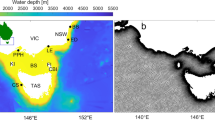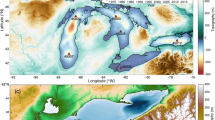Abstract
Hindcast of wave dynamics in Lake Erie during 2002 to 2012 was conducted using a state-of-art finite-volume coastal ocean surface wave model (FVCOM-SWAVE). After model calibration, the surface gravity wave dynamics were examined from the aspects of wave climate and seasonality, inter-basin wave interactions, as well as its potential susceptibility to regional climate change. Compared to the Central and Eastern Basins, the Western Basin has relatively gentle wave climate. The Western Basin and the nearshore areas are most susceptible to the wave-induced bottom orbital oscillations on the seasonal mean scale, and the offshore Central Basin is sensitive to them as well during episodic events. Profound seasonality was found in both mean and extreme wave dynamics during ice-free cycles. Mean significant wave height (SWH) is highest during fall with more occurrences of extreme events (SWH > 3.1 m) and is lowest during summer, which is controlled by wind speed and direction collectively. Besides, swells generated in the Central and Eastern Basins could interact with each other under various wind directions, whereas wave generated in the Central Basin could hardly propagate into the Western Basin. In addition, the regression analysis of surrounding meteorological stations indicates increasing SWH in the Western Basin and decreasing SWH in the Eastern Basin.











Similar content being viewed by others
References
Alves JHG, Chawla A, Tolman HL, Schwab DJ, Lang G, Mann G (2014) The operational implementation of a Great Lakes Wave Forecasting System at NOAA/NCEP*. Weather Forecast 29(6):1473–1497. doi:10.1175/WAF-D-12-00049.1
Anderson FE (1972) Resuspension of estuarine sediments by small amplitude waves. J Sediment Res 42(3). doi:10.1306/74D725D6-2B21-11D7-8648000102C1865D
Anderson JD, Wu CH, Schwab DJ (2015) Wave climatology in the Apostle Islands, Lake Superior. J Geophys Res Oceans 120(7):4869–4890. doi:10.1002/2014JC010278
Ardhuin F, O’Reilly WC, Herbers THC, Jessen PF (2003) Swell transformation across the continental shelf. Part I: attenuation and directional broadening. J Phys Oceanogr 33(9):1921–1939. doi:10.1175/1520-0485(2003)033<1921:STATCS>2.0.CO;2
Bai X, Wang J, Schwab DJ, Yang Y, Luo L, Leshkevich GA, Liu S (2013) Modeling 1993–2008 climatology of seasonal general circulation and thermal structure in the Great Lakes using FVCOM. Ocean Model 65:40–63. doi:10.1016/j.ocemod.2013.02.003
Bartish T (1987) A review of exchange processes among the three basins of Lake Erie. J Great Lakes Res 13(4):607–618. doi:10.1016/S0380-1330(87)71676-1
Bolsenga SJ, Herdendorf CE (1993) Lake Erie and Lake St. Clair handbook. Wayne State Univ. Press, Detroit, USA
Booij N, Holthuijsen LH, Ris RC (1996) The “SWAN” wave model for shallow water. Coast Eng 1:668–672. doi:10.9753/icce.v25.%25p
Brigham EO (1988) The fast Fourier transform and its applications. Prentice Hall, Upper Saddle River, USA
Caliskan H, Valle-Levinson A (2008) Wind-wave transformations in an elongated bay. Cont Shelf Res 28(14):1702–1710. doi:10.1016/j.csr.2008.03.009
Chen C, Huang H, Beardsley RC, Liu H, Xu Q, Cowles G (2007) A finite volume numerical approach for coastal ocean circulation studies: comparison with finite difference models. J Geophys Res Oceans 112:C03018. doi:10.1029/2006JC003485
DHI (2005) Mike 21 spectral wave module. Scientific documentation, Danish Hydraulic Institute (DHI)
Eichenlaub VL (1978) Weather and climate of the Great Lakes region. Univ. of Notre Dame Press, South Bend, Indiana, USA
Ezer T, Arango H, Shchepetkin AF (2002) Developments in terrain-following ocean models: intercomparisons of numerical aspects. Ocean Model 4(3):249–267. doi:10.1016/S1463-5003(02)00003-3
Ge J, Shen F, Guo W, Chen C, Ding P (2015) Estimation of critical shear stress for erosion in the Changjiang Estuary: a synergy research of observation. GOCI sensing and modeling J Geophys Res Oceans 120. doi:10.1002/2015JC010992
Hawley N, Eadie BJ (2007) Observations of sediment transport in Lake Erie during the winter of 2004-2005. J Great Lakes Res 33(4):816–827. doi:10.3394/0380-1330(2007)33(816:OOSTIL)2.0.CO;2
Hawley N, Lesht BM, Schwab DJ (2004) A comparison of observed and modeled surface waves in southern Lake Michigan and the implications for models of sediment resuspension. J Geophys Res Oceans 109(C10). doi:10.1029/2002JC001592
Intergovernmental Panel on Climate Change (2014) Climate change 2014 impacts, adaptation, and vulnerability: regional aspects. Cambridge University Press, New York, USA
Janssen PAEM (1989) Wave-induced stress and the drag of air flow over sea waves. J Phys Oceanogr 19(6):745–754. doi:10.1175/1520-0485(1989)019<0745:WISATD>2.0.CO;2
Janssen PAEM (1991) Quasi-linear theory of wind-wave generation applied to wave forecasting. J Phys Oceanogr 21(11):1631–1642. doi:10.1175/1520-0485(1991)021<1631:QLTOWW>2.0.CO;2
Kang SW, Sheng YP, Lick W (1982) Wave action and bottom shear stresses in Lake Erie. J Great Lakes Res 8(3):482–494. doi:10.1016/S0380-1330(82)71987-2
Kantha L (2006) A note on the decay rate of swell. Ocean Model 11(1):167–173. doi:10.1016/j.ocemod.2004.12.003
Lalbeharry R, Behrens A, Guenther H, Wilson L (2004) An evaluation of wave model performances with linear and nonlinear dissipation source terms in Lake Erie. Proc 8th Int Workshop on Wave Hindcasting and Forecasting, Hawaii, USA
Lesht BM, Hawley N (1987) Near-bottom currents and suspended sediment concentration in southeastern Lake Michigan. J Great Lakes Res 13(3):375–386. doi:10.1016/S0380-1330(87)71659-1
MacKay M, Seglenieks F (2013) On the simulation of Laurentian Great Lakes water levels under projections of global climate change. Clim Chang 117(1–2):55–67. doi:10.1007/s10584-012-0560-z
Mao M, van der Westhuysen AJ, Xia M, Schwab DJ, Chawla A (2016) Modeling wind waves from deep to shallow waters in Lake Michigan using unstructured SWAN. J Geophys Res Oceans:121. doi:10.1002/2015JC011340
Moeini MH, Etemad-Shahidi A (2007) Application of two numerical models for wave hindcasting in Lake Erie. Appl Ocean Res 29(3):137–145. doi:10.1016/j.apor.2007.10.001
Niu Q, Xia M, Rutherford ES, Mason DM, Anderson EJ, Schwab DJ (2015) Investigation of interbasin exchange and interannual variability in Lake Erie using an unstructured-grid hydrodynamic model. J Geophys Res Oceans 120:2212–2232. doi:10.1002/2014JC010457
Powers JG, Stoelinga MT (2000) A coupled air-sea mesoscale model: experiments in atmospheric sensitivity to marine roughness. Mon Weather Rev 128(1):208–228. doi:10.1175/1520-0493(2000)128<0208:ACASMM>2.0.CO;2
Qi J, Chen C, Beardsley RC, Perrie W, Cowles GW, Lai Z (2009) An unstructured-grid finite-volume surface wave model (FVCOM-SWAVE): implementation, validations and applications. Ocean Model 28:153–166. doi:10.1016/j.ocemod.2009.01.007
Rao YR, Schwab DJ (2007) Transport and mixing between the coastal and offshore waters in the Great Lakes: a review. J Great Lakes Res 33(1):202–218. doi:10.3394/0380-1330(2007)33(202:TAMBTC)2.0.CO;2
Schertzer WM, Saylor JH, Boyce FM, Robertson DG, Rosa F (1987) Seasonal thermal cycle of Lake Erie. J Great Lakes Res 13(4):468–486. doi:10.1016/S0380-1330(87)71667-0
Schneggenburger C, Günther H, Rosenthal W (2000) Spectral wave modelling with non-linear dissipation: validation and applications in a coastal tidal environment. Coast Eng 1:201–235. doi:10.1016/S0378-3839(00)00033-8
Schwab DJ, Bennett JR, Liu PC, Donelan MA (1984) Application of a simple numerical wave prediction model to Lake Erie. J Geophys Res: Oceans (1978–2012) 89(C3):3586–3592
Scott D, Schwab DJ, Zuzek P, Padala C (2004) Hindcasting wave conditions on the North American Great Lakes. Proc 8th Int Workshop on Wave Hindcasting and Forecasting, Hawaii, USA.
Soomere T (2005) Wind wave statistics in Tallinn Bay. Boreal Environ Res 10:103–118
Sun Y, Chen C, Beardsley RC, Xu Q, Qi J, Lin H (2013) Impact of current-wave interaction on storm surge simulation: a case study for Hurricane Bob. J Geophys Res Oceans 118(5):2685–2701. doi:10.1002/jgrc.20207
SWAN Team (2006) SWAN Cycle III version 40.51 technical documentation. Delft University of Technology, Faculty of Civil Engineering and Geosciences, Environmental Fluid Mechanics Section, P.O. Box 5048, 2600 GA Delft, The Netherlands, 2006
WAMDI Group (1988) The WAM model—a third generation ocean wave prediction model. J Phys Oceanogr 18:1775–1810. doi:10.1175/1520-0485(1988)018<1775:TWMTGO>2.0.CO;2
Wang D, Yang Y, Wang J, Bai X (2015) A modeling study of the effects of river runoff, tides, and surface wind-wave mixing on the eastern and western Hainan upwelling systems of the South China Sea, China. Ocean Dyn 65(8):1143–1164. doi:10.1007/s10236-015-0857-3
Wu L, Chen C, Guo F, Shi M, Qi J, Ge J (2011) A FVCOM-based unstructured grid wave, current, and sediment transport model. I Model description and validation, J Ocean Univ China 10(1):1–8. doi:10.1007/s11802-011-1788-3
Acknowledgments
This project is funded by the Great Lakes Fishery Commission. Research was carried on NSF Stampede (Support to M. Xia) and Yellowstone (Support to Q. Niu). Research Data is archived at the National Center for Atmospheric Research, Computational and Information Systems Laboratory, Boulder, Colorado. Surface forcing data was provided by the Great Lakes Environmental Research Lab (GLERL), NOAA. Observations of wave characteristics were obtained from the IFYLE, GLERL, NOAA, the National Data Buoy Center, NOAA, and Environmental Canada.
Author information
Authors and Affiliations
Corresponding author
Additional information
Responsible Editor: Tal Ezer
Rights and permissions
About this article
Cite this article
Niu, Q., Xia, M. Wave climatology of Lake Erie based on an unstructured-grid wave model. Ocean Dynamics 66, 1271–1284 (2016). https://doi.org/10.1007/s10236-016-0982-7
Received:
Accepted:
Published:
Issue Date:
DOI: https://doi.org/10.1007/s10236-016-0982-7




